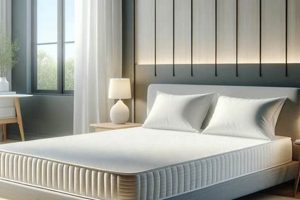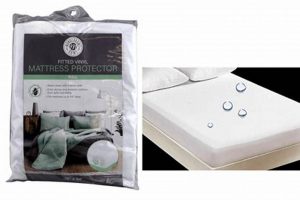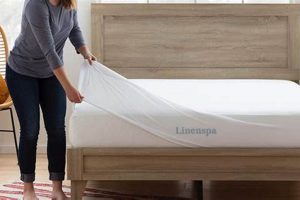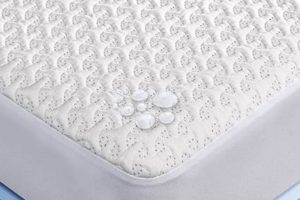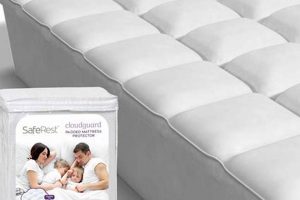This bedding accessory serves as a protective layer for a mattress, crafted from fabric derived from bamboo fibers. It acts as a barrier against liquids, allergens, dust mites, and general wear and tear, thus prolonging the lifespan of the mattress. As an example, if a beverage is spilled on the bed, this covering prevents the liquid from penetrating the mattress itself, safeguarding its cleanliness and integrity.
The adoption of this type of bedding enhancement offers several advantages. The material’s natural hypoallergenic properties make it suitable for individuals with sensitivities. Its breathability promotes airflow, contributing to a cooler and more comfortable sleep environment. Historically, similar protective coverings have been used to enhance hygiene and increase the durability of mattresses; however, the use of bamboo fiber represents a modern approach that prioritizes sustainability and comfort.
The subsequent discussion will delve into the specific attributes of bamboo-derived materials, examine the various types of mattress protection available, and provide guidance on selecting the optimal product for individual needs and preferences.
Guidance for Optimal Utilization
The following directives offer practical advice for maximizing the benefits and longevity of this bedding accessory.
Tip 1: Proper Installation. Ensure the protector is correctly fitted to the mattress, covering all surfaces. A snug fit minimizes movement and maximizes protection against spills and allergens. Elasticized edges or zippered enclosures typically facilitate proper installation.
Tip 2: Regular Cleaning. Adhere to the manufacturer’s washing instructions. Frequent laundering, typically every one to two months, removes accumulated dust mites and allergens, maintaining a hygienic sleep environment. Use a gentle detergent and avoid bleach to preserve the fabric’s integrity.
Tip 3: Immediate Spill Response. In the event of a spill, promptly absorb the liquid with a clean cloth. Address the affected area as quickly as possible to prevent stains and minimize the potential for moisture penetration.
Tip 4: Avoid Excessive Heat. When drying, utilize a low heat setting or air dry to prevent shrinkage or damage to the bamboo fibers. High heat can compromise the protector’s waterproof membrane, reducing its effectiveness.
Tip 5: Inspect Regularly for Wear. Periodically examine the protector for tears, seam separation, or other signs of wear. Promptly address any damage to maintain its protective qualities. Consider replacement if damage is significant.
Tip 6: Pair with Appropriate Bedding. Enhance the comfort and protective qualities by utilizing breathable sheets and other bedding accessories. This promotes airflow and contributes to a more comfortable sleep climate.
Adherence to these guidelines ensures consistent protection and maximizes the lifespan of this essential bedding item, contributing to a cleaner, healthier, and more comfortable sleep environment.
The succeeding section will discuss specific features to consider when selecting a suitable mattress protector, and it will outline common issues and solutions.
1. Hypoallergenic barrier
The primary function of a bamboo mattress protector, particularly concerning its hypoallergenic properties, lies in creating a physical barrier against allergens. This barrier effectively prevents allergens, such as dust mites, pet dander, and pollen, from penetrating the mattress core. The tight weave of the bamboo fabric acts as a sieve, trapping these microscopic irritants on the surface of the protector, where they can be easily removed through regular washing. Without this barrier, allergens would accumulate within the mattress, triggering allergic reactions and respiratory problems for sensitive individuals. For instance, a child with asthma could experience improved sleep quality due to the reduced presence of dust mites in their sleep environment, thanks to the protective layer.
The efficacy of this hypoallergenic barrier is directly related to the quality and construction of the bamboo fabric. A denser weave provides a more effective barrier against smaller allergens. Furthermore, some protectors feature additional treatments, such as antimicrobial finishes, that further inhibit the growth of bacteria and mold, contributing to a cleaner and healthier sleep surface. Practical applications extend beyond allergy sufferers, benefiting anyone seeking a more hygienic sleep environment. In healthcare settings, these protectors are crucial for minimizing the spread of pathogens and maintaining a sanitary patient care area.
In summary, the hypoallergenic barrier is an integral component of a bamboo mattress protector, serving as a first line of defense against common allergens. Its effectiveness depends on the quality of the materials and the diligence with which it is maintained through regular cleaning. Understanding this connection allows consumers to make informed choices, selecting products that best meet their individual needs and prioritize their health and well-being. The ongoing challenge lies in developing even more effective and durable barrier technologies to provide superior protection against an ever-increasing range of environmental irritants.
2. Moisture Absorption
Moisture absorption is a critical function of a mattress protector, particularly when constructed from bamboo fibers. This characteristic impacts hygiene, comfort, and the lifespan of the mattress itself. The natural properties of bamboo contribute significantly to its ability to manage moisture, making it a beneficial material for this application.
- Regulation of Sleep Climate
Bamboo fibers possess inherent wicking capabilities, drawing moisture away from the body during sleep. This process facilitates evaporation, thereby regulating body temperature and preventing overheating. Individuals who experience night sweats or live in humid climates can particularly benefit from this feature. For instance, a bamboo protector can help maintain a comfortable sleep temperature by dissipating moisture caused by perspiration.
- Prevention of Mold and Mildew Growth
The absorption and subsequent evaporation of moisture reduce the likelihood of mold and mildew formation within the mattress. A damp environment fosters the growth of these microorganisms, which can trigger allergic reactions and compromise air quality. By minimizing moisture accumulation, the protector inhibits microbial proliferation, contributing to a healthier sleep environment. Failure to control moisture can lead to irreversible damage to the mattress core, necessitating premature replacement.
- Protection Against Stains and Damage
Moisture absorption helps to prevent liquids from penetrating the mattress surface, thus guarding against stains and potential internal damage. Spills, accidental incontinence, or even excessive perspiration can compromise the integrity of the mattress. The protector acts as a sacrificial layer, absorbing the moisture and preventing it from reaching the absorbent materials within the mattress. This function extends the lifespan of the mattress and preserves its aesthetic appeal.
- Enhanced Breathability
The ability to absorb and release moisture is linked to the overall breathability of the fabric. Bamboo fibers create a more porous structure compared to synthetic materials, allowing for better air circulation. This enhanced breathability further aids in temperature regulation and prevents the buildup of moisture vapor within the bedding. A more breathable mattress protector promotes a drier, cooler, and more comfortable sleep environment.
The interplay between moisture absorption, breathability, and protection from spills and microbial growth underscores the significance of this characteristic in bamboo mattress protectors. This function not only enhances comfort and hygiene but also contributes to the long-term preservation of the mattress. Selecting a protector with superior moisture management capabilities represents a proactive approach to maintaining a clean, healthy, and comfortable sleep environment.
3. Temperature regulation
The connection between temperature regulation and a protector constructed from bamboo fibers is a critical consideration for optimizing sleep quality. Bamboo fibers possess inherent properties that facilitate thermal regulation, influencing the sleep environment in several key ways. The porous structure of the fibers promotes airflow, allowing for enhanced breathability compared to synthetic materials. This increased airflow helps dissipate heat and prevent the buildup of warm, stagnant air between the sleeper and the mattress. A practical example is that individuals who tend to overheat during the night may experience a reduction in perspiration and improved comfort when utilizing this type of protector. The cause is the material’s increased airflow, and the effect is a more consistent and comfortable sleeping temperature.
Furthermore, the moisture-wicking capability of bamboo contributes to temperature regulation. By drawing moisture away from the body, the fabric facilitates evaporative cooling. This is particularly beneficial in warmer climates or for individuals experiencing night sweats. The protector assists in maintaining a drier sleep surface, which reduces the sensation of dampness and discomfort often associated with temperature fluctuations. Consider the scenario of a person experiencing hormonal fluctuations leading to increased body temperature; a bamboo protector can help mitigate the resulting discomfort through its moisture-wicking properties. The practical application is therefore the improvement of sleep quality by mitigating the adverse effects of temperature variations.
In summary, the significance of temperature regulation as a component of a bamboo mattress protector cannot be overstated. The material’s breathability and moisture-wicking capabilities work in concert to create a more consistent and comfortable sleep environment. While individual experiences may vary, understanding these fundamental properties allows consumers to make informed decisions regarding their bedding choices, specifically considering their personal temperature preferences and environmental factors. The challenge remains in further optimizing the fabric’s thermal regulation properties through innovative weaving techniques and material blends, continuously improving sleep comfort for a diverse range of users.
4. Prolonged mattress life
The service life of a mattress is directly influenced by its exposure to various degrading factors. These factors include moisture, spills, allergens, dust mites, and general wear and tear. A protector serves as a physical barrier, mitigating the impact of these elements and, consequently, extending the functional lifespan of the mattress. For instance, a mattress without protection that repeatedly absorbs perspiration and body oils will degrade more rapidly than one shielded by a barrier. This accelerated degradation manifests as reduced support, uneven surfaces, and the development of unpleasant odors. Using a bamboo mattress protector helps to prevent these issues from occurring in the first place by keeping them away from the mattress.
The bamboo composition of certain protectors offers specific advantages in preserving mattress integrity. The inherent moisture-wicking properties of bamboo fibers help to regulate moisture levels, preventing the buildup of humidity that can foster mold and mildew growth within the mattress core. The hypoallergenic nature of the material also minimizes the accumulation of allergens and dust mites, reducing the need for frequent and potentially damaging cleaning procedures. A practical example is the use of these protectors in hospitality settings. Hotels often employ mattress protectors to safeguard their investments and ensure guest comfort. By using protectors, hotels can avoid having to replace mattresses more often than they’d like, saving on expenses for many reasons like stains or wear and tear.
In summary, the implementation of a bamboo mattress protector directly correlates with the prolonged lifespan of the mattress. The protective layer shields the mattress from damaging elements, preserves its structural integrity, and minimizes the need for aggressive cleaning. While the initial investment in a quality protector represents an additional cost, the long-term savings associated with extended mattress life and improved hygiene make it a fiscally sound decision. The challenge lies in educating consumers on the tangible benefits of mattress protection and encouraging the adoption of preventive measures to safeguard their sleep investments.
5. Dust mite resistance
The correlation between dust mite resistance and a bamboo mattress protector stems from the intrinsic properties of the bamboo fibers and the construction techniques employed. Dust mites, microscopic arthropods that thrive in bedding and upholstery, are a significant trigger for allergies and asthma. The tight weave of quality bamboo fabric creates a physical barrier that inhibits dust mite penetration into the mattress core. This barrier effect reduces the dust mite population within the mattress, thereby minimizing allergen exposure. For instance, individuals with dust mite allergies who experience nighttime congestion may find relief by using a protector that impedes mite proliferation.
The effectiveness of dust mite resistance is amplified by the moisture-wicking characteristics of bamboo. Dust mites flourish in humid environments; bamboo’s ability to draw moisture away from the sleeping surface creates a less hospitable habitat. Moreover, some protectors incorporate antimicrobial treatments that further inhibit the growth of dust mites and other microorganisms. Practical applications extend to various settings, including homes, hotels, and healthcare facilities, where maintaining a hypoallergenic environment is critical. The selection of a protector specifically designed for dust mite resistance, often indicated by certifications or testing data, provides an enhanced level of protection. This helps maintain cleaner mattresses.
In summary, the dust mite resistance afforded by a bamboo mattress protector is a consequential feature for promoting respiratory health and improving sleep quality. The combination of a tightly woven fabric, moisture management, and, in some cases, antimicrobial treatments creates an environment less conducive to dust mite proliferation. While consistent laundering remains essential, the barrier effect offered by the protector significantly reduces dust mite exposure. The challenge lies in consistently evaluating and improving the effectiveness of these protectors in combating dust mites and other allergens, ensuring ongoing protection for consumers.
6. Easy maintenance
The association between easy maintenance and a mattress protector derived from bamboo centers on simplified cleaning procedures and inherent material properties. Bamboo fibers exhibit natural resistance to stains and odors, reducing the frequency and intensity of cleaning required compared to protectors made from synthetic materials. This characteristic translates directly to reduced time and effort dedicated to maintaining a hygienic sleep environment. For example, minor spills on a bamboo protector are often easily removed with a damp cloth, preventing the need for immediate machine washing. The ease of maintenance also contributes to the product’s lifespan, as less frequent washing minimizes wear and tear on the fabric.
The practical application of easy maintenance extends to diverse user groups. Individuals with busy lifestyles, families with young children prone to accidents, and those with limited mobility all benefit from the simplified cleaning requirements. The machine-washable nature of most bamboo protectors further enhances convenience. However, adherence to manufacturer’s instructions is crucial; improper washing or drying techniques can compromise the protector’s waterproof membrane or cause shrinkage. Easy maintenance also contributes to overall hygiene by facilitating regular cleaning to remove allergens and dust mites, thereby promoting a healthier sleep environment. For instance, simply removing and washing a bamboo protector monthly can help prevent allergens, dust and other debris.
In summary, the easy maintenance aspect of a bamboo mattress protector is a significant advantage, offering convenience, promoting hygiene, and contributing to product longevity. While the specific cleaning requirements may vary across different brands and models, the inherent stain and odor resistance of bamboo fibers generally simplifies the maintenance process. The ongoing challenge lies in optimizing the fabric’s construction and treatment to further enhance its stain resistance and durability, ensuring consistent performance and user satisfaction over time.
7. Sustainable material
The consideration of sustainability in the selection of materials for bedding components, including mattress protectors, has gained prominence due to increasing environmental awareness. A mattress protector sourced from bamboo is often positioned as an ecologically responsible alternative to those made from synthetic fibers. The premise of this claim requires examination of the environmental impact across the material’s lifecycle, from cultivation and processing to disposal.
- Rapid Renewability
Bamboo is characterized by its exceptionally rapid growth rate, surpassing that of most tree species. This characteristic allows for frequent harvesting without causing long-term depletion of the resource. In practical terms, bamboo plantations can yield significantly more fiber per acre per year compared to cotton or timber, rendering it a potentially more efficient source of raw material for textile production. The reduced harvesting cycle diminishes the strain on land resources and contributes to carbon sequestration. For instance, the rapid replenishment of bamboo stocks minimizes deforestation pressures that might arise from reliance on slower-growing alternatives.
- Reduced Reliance on Pesticides and Fertilizers
In many growing regions, bamboo cultivation requires minimal or no application of pesticides or synthetic fertilizers. The plant’s natural resilience to pests and diseases reduces the environmental impact associated with chemical inputs. This is in stark contrast to conventional cotton farming, which often relies heavily on pesticides and fertilizers, leading to soil degradation, water pollution, and biodiversity loss. The lower chemical dependency associated with bamboo cultivation contributes to a more sustainable agricultural system, benefiting both the environment and the health of farm workers.
- Biodegradability and Reduced Waste
Bamboo fibers are naturally biodegradable, meaning they decompose more readily in landfill conditions compared to synthetic materials like polyester or polyurethane. This characteristic reduces the accumulation of non-degradable waste in landfills and minimizes the environmental burden associated with disposal. While the specific decomposition rate depends on landfill conditions, the inherent biodegradability of bamboo fibers offers a more sustainable end-of-life option. The reduced persistence of bamboo-derived products in the environment aligns with principles of circular economy and waste minimization.
- Water Usage Efficiency
Bamboo generally requires less water for cultivation compared to many other textile crops, particularly cotton. This water efficiency is especially significant in regions facing water scarcity. The reduced irrigation needs of bamboo farming minimize the strain on freshwater resources and contribute to more sustainable water management practices. For instance, switching from water-intensive crops like cotton to bamboo can alleviate pressure on local water supplies and reduce the risk of water-related conflicts.
The multifaceted environmental benefits associated with bamboo, including rapid renewability, reduced chemical inputs, biodegradability, and water efficiency, underscore its potential as a sustainable material for mattress protectors. However, it is crucial to acknowledge that the sustainability of the final product also depends on the manufacturing processes employed, including fiber extraction, dyeing, and finishing. Consumers seeking ecologically sound products should therefore consider certifications that verify sustainable sourcing and production practices.
Frequently Asked Questions
The following addresses prevalent inquiries concerning the attributes, functionality, and selection of mattress protectors incorporating bamboo-derived materials.
Question 1: What distinguishes a bamboo mattress protector from one composed of synthetic materials?
A key distinction lies in the inherent properties of bamboo fibers. These fibers offer enhanced breathability, moisture-wicking capabilities, and a softer texture compared to synthetic alternatives. Additionally, bamboo is often cultivated with fewer pesticides and herbicides, presenting a potentially more sustainable option.
Question 2: Does a protector composed of bamboo offer adequate protection against liquids and spills?
The level of protection varies depending on the construction and specific features of the protector. While bamboo fibers are naturally absorbent, a truly waterproof protector typically incorporates a backing layer, such as polyurethane. Verification of waterproof capabilities is advised prior to purchase.
Question 3: How does the maintenance of a bamboo mattress protector differ from that of other types of protectors?
Generally, bamboo protectors are machine washable. However, adherence to the manufacturer’s care instructions is essential. The use of gentle detergents and low heat settings is recommended to preserve the integrity of the fibers and any waterproof layers.
Question 4: Is a bamboo mattress protector suitable for individuals with allergies?
Bamboo fibers are naturally hypoallergenic, which can benefit individuals with sensitivities. However, it is imperative to select a protector specifically designed to resist dust mites and other allergens. Regular washing further minimizes allergen accumulation.
Question 5: What factors should be considered when selecting a bamboo mattress protector?
Critical considerations include the quality of the bamboo fabric, the presence of a waterproof barrier, the ease of maintenance, and the fit and compatibility with the mattress dimensions. Certifications verifying sustainable sourcing and production practices may also be relevant.
Question 6: How does a bamboo mattress protector contribute to temperature regulation during sleep?
The breathability of bamboo fibers promotes airflow, facilitating the dissipation of heat and moisture. This contributes to a cooler and more comfortable sleep environment, particularly for individuals prone to overheating.
In summary, a protector crafted from bamboo can offer a confluence of benefits, including enhanced comfort, moisture management, and potential sustainability advantages. Informed selection, based on individual needs and product specifications, is paramount.
The following discussion will focus on the impact of bamboo source and manufacturing variations on product performance and environmental footprint.
Conclusion
This exploration has elucidated the multifaceted attributes and benefits associated with the use of a bamboo mattress protector. From its hypoallergenic properties and moisture-wicking capabilities to its potential for sustainable sourcing, this bedding accessory presents a compelling alternative to conventional materials. The capacity to prolong mattress life, coupled with ease of maintenance, further enhances its practical value.
Informed consumers must critically assess product specifications and manufacturing processes to ensure alignment with individual needs and environmental principles. Continued innovation in textile technology and sustainable practices will undoubtedly shape the future of mattress protection, offering enhanced performance and minimized ecological impact. The judicious selection and utilization of a bamboo mattress protector can contribute to a healthier, more comfortable, and environmentally conscious sleep environment.


